British Airways: Internal, External Analysis and Leadership Styles
VerifiedAdded on 2022/11/24
|9
|3695
|77
Report
AI Summary
This report provides a comprehensive analysis of the business context of British Airways, a major UK-based airline. It begins with an introduction to business strategy and its application to British Airways. The report then conducts a SWOT analysis to evaluate the airline's internal strengths and weaknesses, as well as external opportunities and threats. A PESTLE analysis is also performed to examine the political, economic, social, technological, legal, and environmental factors impacting the airline. The report assesses the impact of PESTLE factors on the airline's opportunities and threats, and explains how the organization leverages its strengths to mitigate weaknesses and threats. Various leadership styles are compared, and the report comments on the most appropriate leadership and management style for the airline industry. Finally, the report evaluates the process of corporate social responsibility followed by British Airways. The report concludes with a summary of the findings and recommendations.
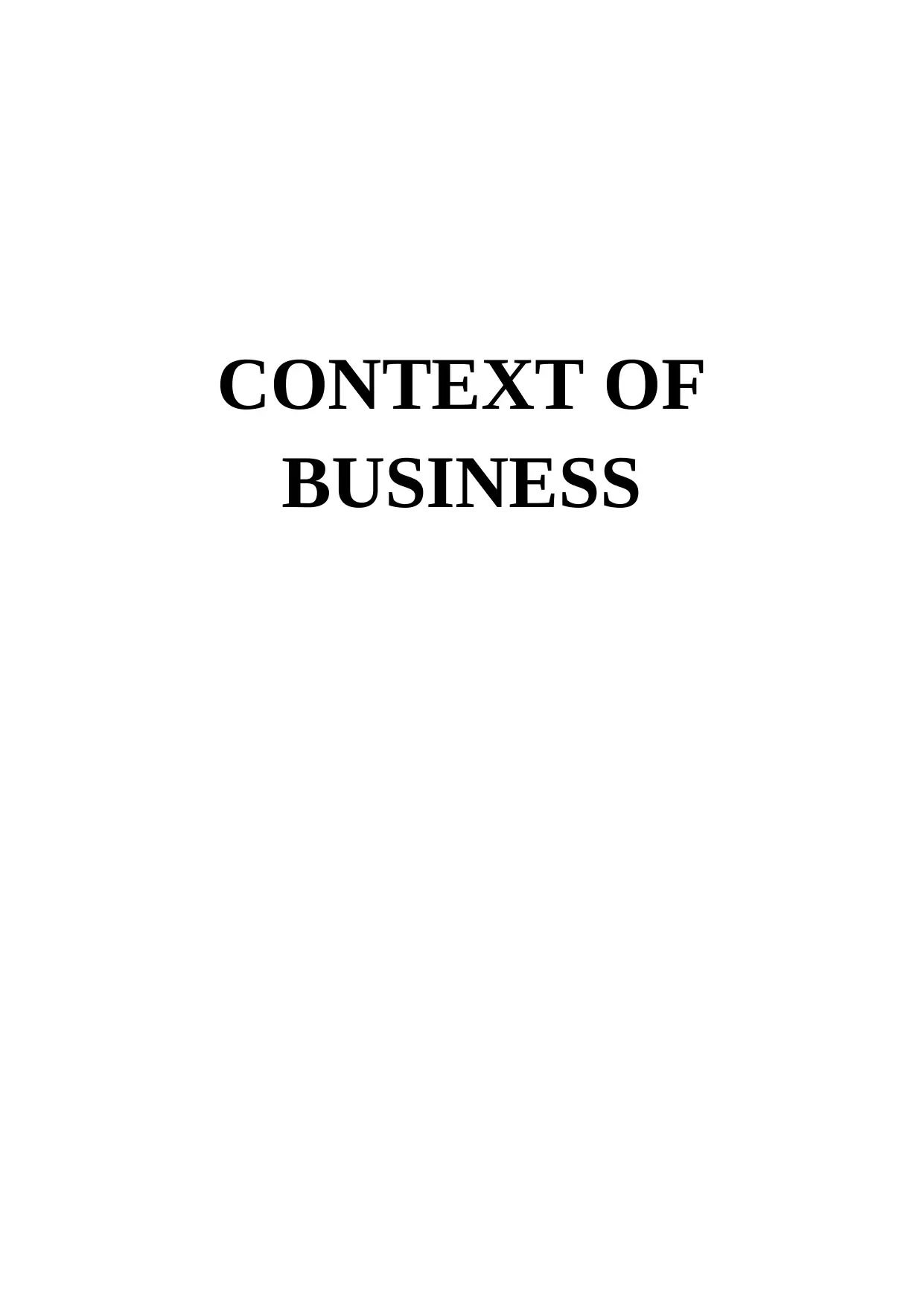
CONTEXT OF
BUSINESS
BUSINESS
Paraphrase This Document
Need a fresh take? Get an instant paraphrase of this document with our AI Paraphraser
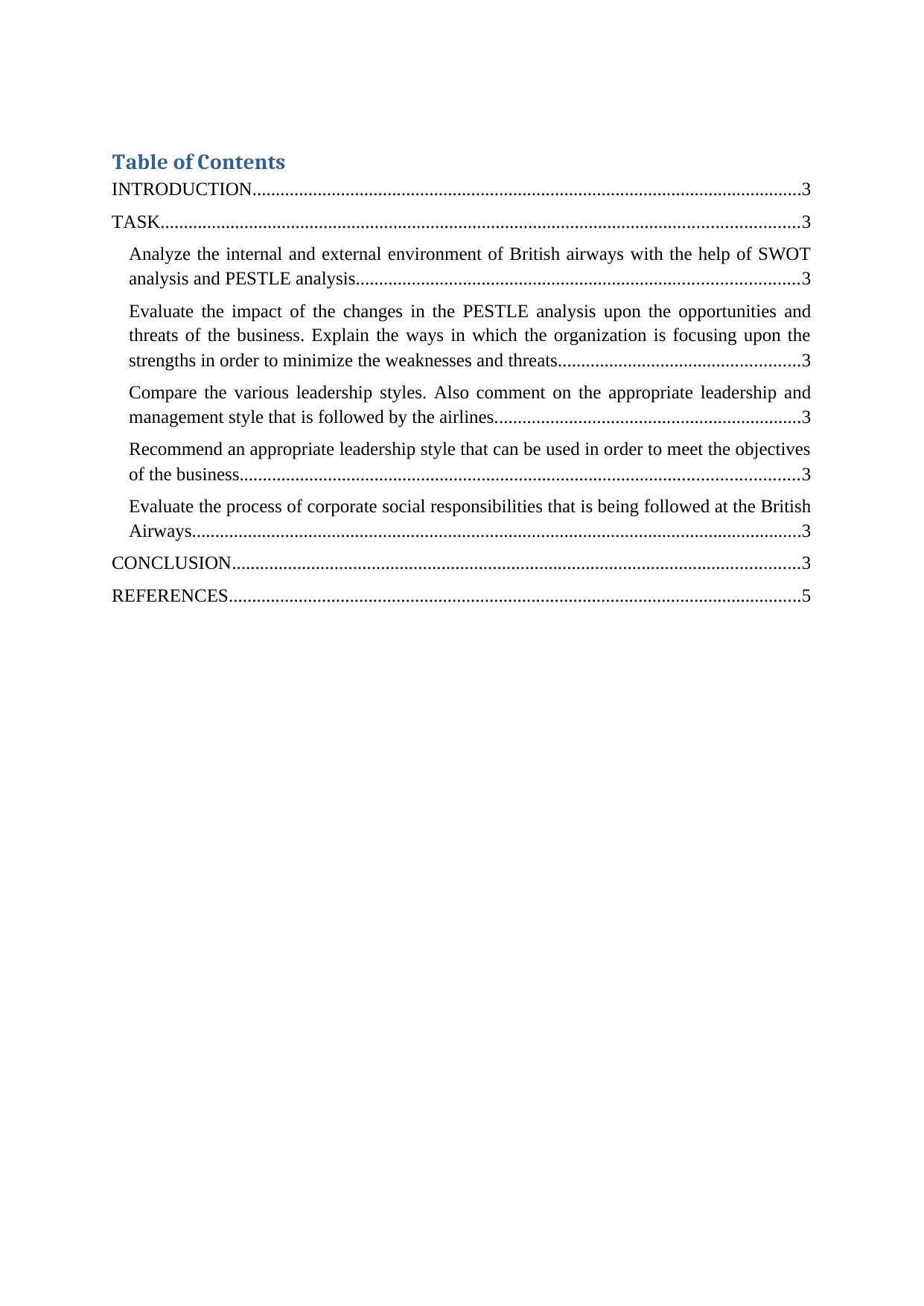
Table of Contents
INTRODUCTION......................................................................................................................3
TASK.........................................................................................................................................3
Analyze the internal and external environment of British airways with the help of SWOT
analysis and PESTLE analysis...............................................................................................3
Evaluate the impact of the changes in the PESTLE analysis upon the opportunities and
threats of the business. Explain the ways in which the organization is focusing upon the
strengths in order to minimize the weaknesses and threats....................................................3
Compare the various leadership styles. Also comment on the appropriate leadership and
management style that is followed by the airlines..................................................................3
Recommend an appropriate leadership style that can be used in order to meet the objectives
of the business........................................................................................................................3
Evaluate the process of corporate social responsibilities that is being followed at the British
Airways...................................................................................................................................3
CONCLUSION..........................................................................................................................3
REFERENCES...........................................................................................................................5
INTRODUCTION......................................................................................................................3
TASK.........................................................................................................................................3
Analyze the internal and external environment of British airways with the help of SWOT
analysis and PESTLE analysis...............................................................................................3
Evaluate the impact of the changes in the PESTLE analysis upon the opportunities and
threats of the business. Explain the ways in which the organization is focusing upon the
strengths in order to minimize the weaknesses and threats....................................................3
Compare the various leadership styles. Also comment on the appropriate leadership and
management style that is followed by the airlines..................................................................3
Recommend an appropriate leadership style that can be used in order to meet the objectives
of the business........................................................................................................................3
Evaluate the process of corporate social responsibilities that is being followed at the British
Airways...................................................................................................................................3
CONCLUSION..........................................................................................................................3
REFERENCES...........................................................................................................................5
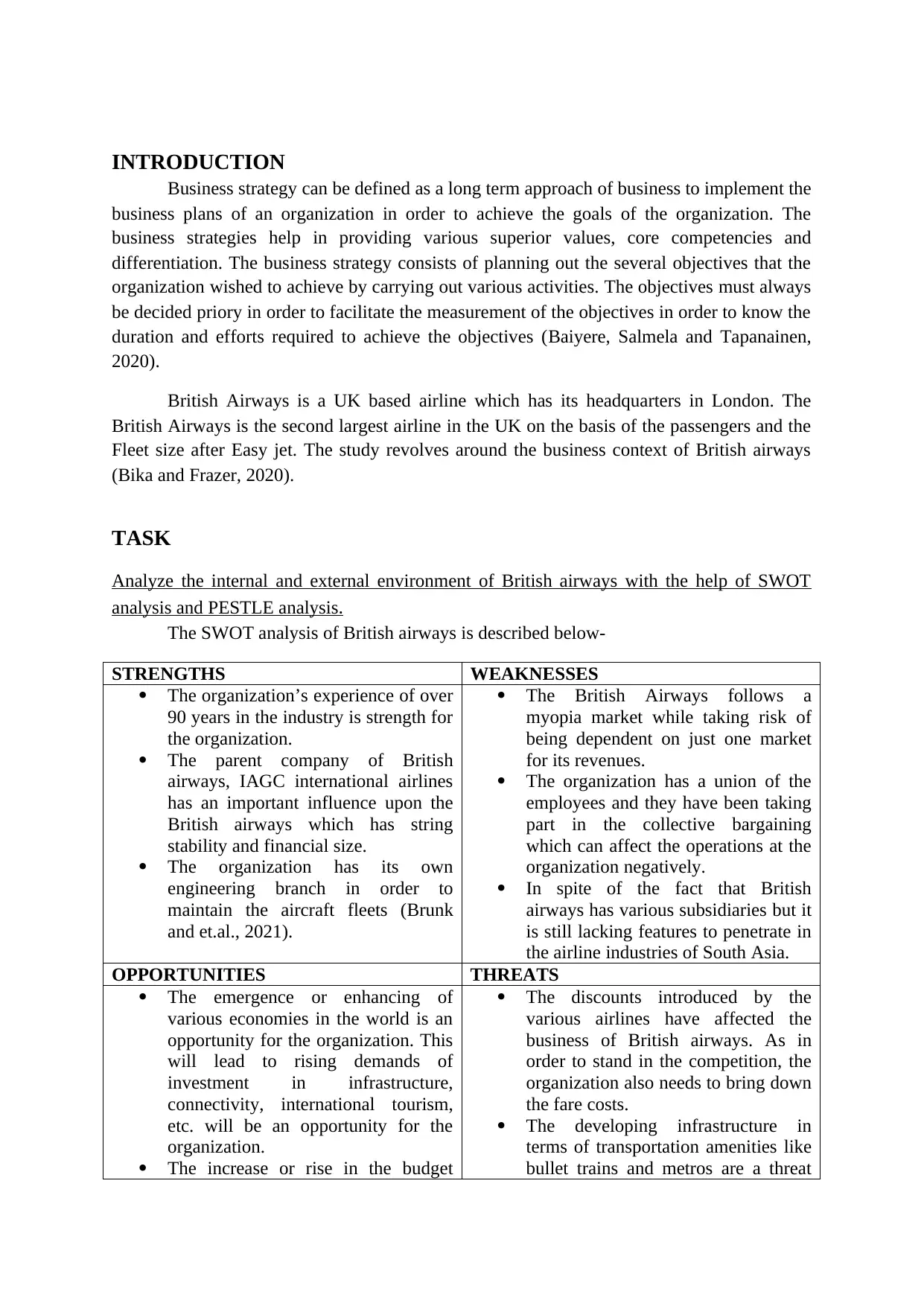
INTRODUCTION
Business strategy can be defined as a long term approach of business to implement the
business plans of an organization in order to achieve the goals of the organization. The
business strategies help in providing various superior values, core competencies and
differentiation. The business strategy consists of planning out the several objectives that the
organization wished to achieve by carrying out various activities. The objectives must always
be decided priory in order to facilitate the measurement of the objectives in order to know the
duration and efforts required to achieve the objectives (Baiyere, Salmela and Tapanainen,
2020).
British Airways is a UK based airline which has its headquarters in London. The
British Airways is the second largest airline in the UK on the basis of the passengers and the
Fleet size after Easy jet. The study revolves around the business context of British airways
(Bika and Frazer, 2020).
TASK
Analyze the internal and external environment of British airways with the help of SWOT
analysis and PESTLE analysis.
The SWOT analysis of British airways is described below-
STRENGTHS WEAKNESSES
The organization’s experience of over
90 years in the industry is strength for
the organization.
The parent company of British
airways, IAGC international airlines
has an important influence upon the
British airways which has string
stability and financial size.
The organization has its own
engineering branch in order to
maintain the aircraft fleets (Brunk
and et.al., 2021).
The British Airways follows a
myopia market while taking risk of
being dependent on just one market
for its revenues.
The organization has a union of the
employees and they have been taking
part in the collective bargaining
which can affect the operations at the
organization negatively.
In spite of the fact that British
airways has various subsidiaries but it
is still lacking features to penetrate in
the airline industries of South Asia.
OPPORTUNITIES THREATS
The emergence or enhancing of
various economies in the world is an
opportunity for the organization. This
will lead to rising demands of
investment in infrastructure,
connectivity, international tourism,
etc. will be an opportunity for the
organization.
The increase or rise in the budget
The discounts introduced by the
various airlines have affected the
business of British airways. As in
order to stand in the competition, the
organization also needs to bring down
the fare costs.
The developing infrastructure in
terms of transportation amenities like
bullet trains and metros are a threat
Business strategy can be defined as a long term approach of business to implement the
business plans of an organization in order to achieve the goals of the organization. The
business strategies help in providing various superior values, core competencies and
differentiation. The business strategy consists of planning out the several objectives that the
organization wished to achieve by carrying out various activities. The objectives must always
be decided priory in order to facilitate the measurement of the objectives in order to know the
duration and efforts required to achieve the objectives (Baiyere, Salmela and Tapanainen,
2020).
British Airways is a UK based airline which has its headquarters in London. The
British Airways is the second largest airline in the UK on the basis of the passengers and the
Fleet size after Easy jet. The study revolves around the business context of British airways
(Bika and Frazer, 2020).
TASK
Analyze the internal and external environment of British airways with the help of SWOT
analysis and PESTLE analysis.
The SWOT analysis of British airways is described below-
STRENGTHS WEAKNESSES
The organization’s experience of over
90 years in the industry is strength for
the organization.
The parent company of British
airways, IAGC international airlines
has an important influence upon the
British airways which has string
stability and financial size.
The organization has its own
engineering branch in order to
maintain the aircraft fleets (Brunk
and et.al., 2021).
The British Airways follows a
myopia market while taking risk of
being dependent on just one market
for its revenues.
The organization has a union of the
employees and they have been taking
part in the collective bargaining
which can affect the operations at the
organization negatively.
In spite of the fact that British
airways has various subsidiaries but it
is still lacking features to penetrate in
the airline industries of South Asia.
OPPORTUNITIES THREATS
The emergence or enhancing of
various economies in the world is an
opportunity for the organization. This
will lead to rising demands of
investment in infrastructure,
connectivity, international tourism,
etc. will be an opportunity for the
organization.
The increase or rise in the budget
The discounts introduced by the
various airlines have affected the
business of British airways. As in
order to stand in the competition, the
organization also needs to bring down
the fare costs.
The developing infrastructure in
terms of transportation amenities like
bullet trains and metros are a threat
⊘ This is a preview!⊘
Do you want full access?
Subscribe today to unlock all pages.

Trusted by 1+ million students worldwide
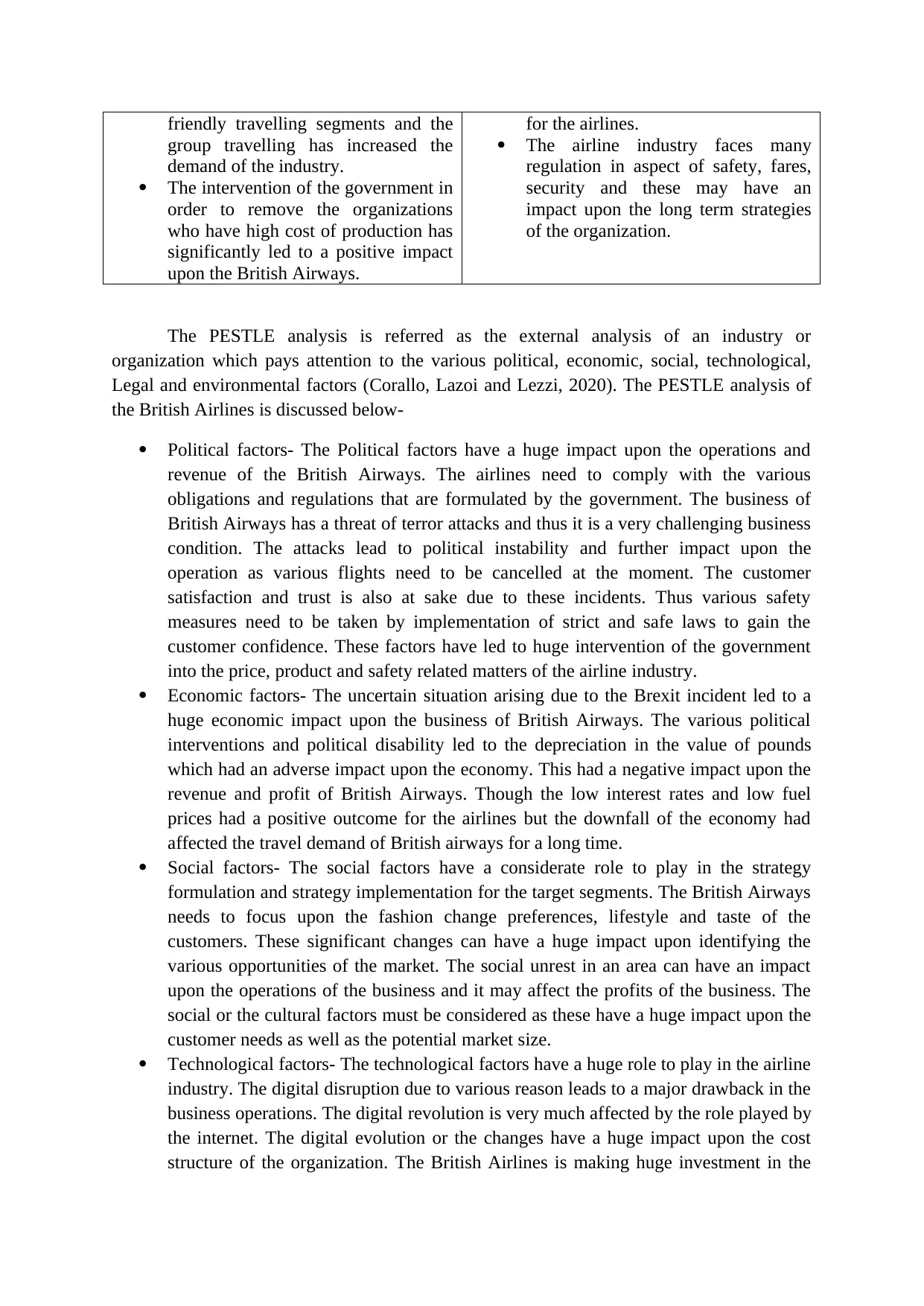
friendly travelling segments and the
group travelling has increased the
demand of the industry.
The intervention of the government in
order to remove the organizations
who have high cost of production has
significantly led to a positive impact
upon the British Airways.
for the airlines.
The airline industry faces many
regulation in aspect of safety, fares,
security and these may have an
impact upon the long term strategies
of the organization.
The PESTLE analysis is referred as the external analysis of an industry or
organization which pays attention to the various political, economic, social, technological,
Legal and environmental factors (Corallo, Lazoi and Lezzi, 2020). The PESTLE analysis of
the British Airlines is discussed below-
Political factors- The Political factors have a huge impact upon the operations and
revenue of the British Airways. The airlines need to comply with the various
obligations and regulations that are formulated by the government. The business of
British Airways has a threat of terror attacks and thus it is a very challenging business
condition. The attacks lead to political instability and further impact upon the
operation as various flights need to be cancelled at the moment. The customer
satisfaction and trust is also at sake due to these incidents. Thus various safety
measures need to be taken by implementation of strict and safe laws to gain the
customer confidence. These factors have led to huge intervention of the government
into the price, product and safety related matters of the airline industry.
Economic factors- The uncertain situation arising due to the Brexit incident led to a
huge economic impact upon the business of British Airways. The various political
interventions and political disability led to the depreciation in the value of pounds
which had an adverse impact upon the economy. This had a negative impact upon the
revenue and profit of British Airways. Though the low interest rates and low fuel
prices had a positive outcome for the airlines but the downfall of the economy had
affected the travel demand of British airways for a long time.
Social factors- The social factors have a considerate role to play in the strategy
formulation and strategy implementation for the target segments. The British Airways
needs to focus upon the fashion change preferences, lifestyle and taste of the
customers. These significant changes can have a huge impact upon identifying the
various opportunities of the market. The social unrest in an area can have an impact
upon the operations of the business and it may affect the profits of the business. The
social or the cultural factors must be considered as these have a huge impact upon the
customer needs as well as the potential market size.
Technological factors- The technological factors have a huge role to play in the airline
industry. The digital disruption due to various reason leads to a major drawback in the
business operations. The digital revolution is very much affected by the role played by
the internet. The digital evolution or the changes have a huge impact upon the cost
structure of the organization. The British Airlines is making huge investment in the
group travelling has increased the
demand of the industry.
The intervention of the government in
order to remove the organizations
who have high cost of production has
significantly led to a positive impact
upon the British Airways.
for the airlines.
The airline industry faces many
regulation in aspect of safety, fares,
security and these may have an
impact upon the long term strategies
of the organization.
The PESTLE analysis is referred as the external analysis of an industry or
organization which pays attention to the various political, economic, social, technological,
Legal and environmental factors (Corallo, Lazoi and Lezzi, 2020). The PESTLE analysis of
the British Airlines is discussed below-
Political factors- The Political factors have a huge impact upon the operations and
revenue of the British Airways. The airlines need to comply with the various
obligations and regulations that are formulated by the government. The business of
British Airways has a threat of terror attacks and thus it is a very challenging business
condition. The attacks lead to political instability and further impact upon the
operation as various flights need to be cancelled at the moment. The customer
satisfaction and trust is also at sake due to these incidents. Thus various safety
measures need to be taken by implementation of strict and safe laws to gain the
customer confidence. These factors have led to huge intervention of the government
into the price, product and safety related matters of the airline industry.
Economic factors- The uncertain situation arising due to the Brexit incident led to a
huge economic impact upon the business of British Airways. The various political
interventions and political disability led to the depreciation in the value of pounds
which had an adverse impact upon the economy. This had a negative impact upon the
revenue and profit of British Airways. Though the low interest rates and low fuel
prices had a positive outcome for the airlines but the downfall of the economy had
affected the travel demand of British airways for a long time.
Social factors- The social factors have a considerate role to play in the strategy
formulation and strategy implementation for the target segments. The British Airways
needs to focus upon the fashion change preferences, lifestyle and taste of the
customers. These significant changes can have a huge impact upon identifying the
various opportunities of the market. The social unrest in an area can have an impact
upon the operations of the business and it may affect the profits of the business. The
social or the cultural factors must be considered as these have a huge impact upon the
customer needs as well as the potential market size.
Technological factors- The technological factors have a huge role to play in the airline
industry. The digital disruption due to various reason leads to a major drawback in the
business operations. The digital revolution is very much affected by the role played by
the internet. The digital evolution or the changes have a huge impact upon the cost
structure of the organization. The British Airlines is making huge investment in the
Paraphrase This Document
Need a fresh take? Get an instant paraphrase of this document with our AI Paraphraser
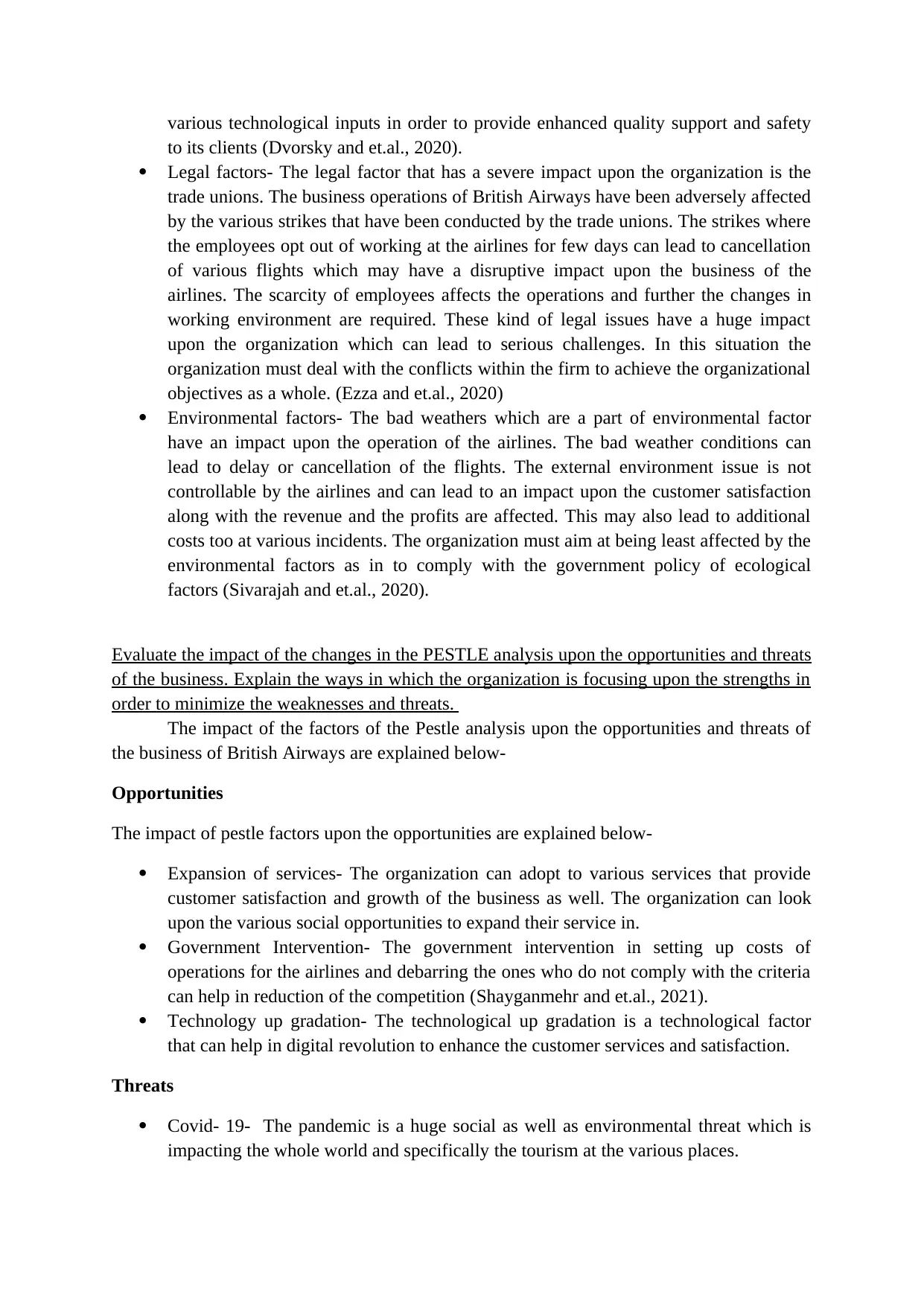
various technological inputs in order to provide enhanced quality support and safety
to its clients (Dvorsky and et.al., 2020).
Legal factors- The legal factor that has a severe impact upon the organization is the
trade unions. The business operations of British Airways have been adversely affected
by the various strikes that have been conducted by the trade unions. The strikes where
the employees opt out of working at the airlines for few days can lead to cancellation
of various flights which may have a disruptive impact upon the business of the
airlines. The scarcity of employees affects the operations and further the changes in
working environment are required. These kind of legal issues have a huge impact
upon the organization which can lead to serious challenges. In this situation the
organization must deal with the conflicts within the firm to achieve the organizational
objectives as a whole. (Ezza and et.al., 2020)
Environmental factors- The bad weathers which are a part of environmental factor
have an impact upon the operation of the airlines. The bad weather conditions can
lead to delay or cancellation of the flights. The external environment issue is not
controllable by the airlines and can lead to an impact upon the customer satisfaction
along with the revenue and the profits are affected. This may also lead to additional
costs too at various incidents. The organization must aim at being least affected by the
environmental factors as in to comply with the government policy of ecological
factors (Sivarajah and et.al., 2020).
Evaluate the impact of the changes in the PESTLE analysis upon the opportunities and threats
of the business. Explain the ways in which the organization is focusing upon the strengths in
order to minimize the weaknesses and threats.
The impact of the factors of the Pestle analysis upon the opportunities and threats of
the business of British Airways are explained below-
Opportunities
The impact of pestle factors upon the opportunities are explained below-
Expansion of services- The organization can adopt to various services that provide
customer satisfaction and growth of the business as well. The organization can look
upon the various social opportunities to expand their service in.
Government Intervention- The government intervention in setting up costs of
operations for the airlines and debarring the ones who do not comply with the criteria
can help in reduction of the competition (Shayganmehr and et.al., 2021).
Technology up gradation- The technological up gradation is a technological factor
that can help in digital revolution to enhance the customer services and satisfaction.
Threats
Covid- 19- The pandemic is a huge social as well as environmental threat which is
impacting the whole world and specifically the tourism at the various places.
to its clients (Dvorsky and et.al., 2020).
Legal factors- The legal factor that has a severe impact upon the organization is the
trade unions. The business operations of British Airways have been adversely affected
by the various strikes that have been conducted by the trade unions. The strikes where
the employees opt out of working at the airlines for few days can lead to cancellation
of various flights which may have a disruptive impact upon the business of the
airlines. The scarcity of employees affects the operations and further the changes in
working environment are required. These kind of legal issues have a huge impact
upon the organization which can lead to serious challenges. In this situation the
organization must deal with the conflicts within the firm to achieve the organizational
objectives as a whole. (Ezza and et.al., 2020)
Environmental factors- The bad weathers which are a part of environmental factor
have an impact upon the operation of the airlines. The bad weather conditions can
lead to delay or cancellation of the flights. The external environment issue is not
controllable by the airlines and can lead to an impact upon the customer satisfaction
along with the revenue and the profits are affected. This may also lead to additional
costs too at various incidents. The organization must aim at being least affected by the
environmental factors as in to comply with the government policy of ecological
factors (Sivarajah and et.al., 2020).
Evaluate the impact of the changes in the PESTLE analysis upon the opportunities and threats
of the business. Explain the ways in which the organization is focusing upon the strengths in
order to minimize the weaknesses and threats.
The impact of the factors of the Pestle analysis upon the opportunities and threats of
the business of British Airways are explained below-
Opportunities
The impact of pestle factors upon the opportunities are explained below-
Expansion of services- The organization can adopt to various services that provide
customer satisfaction and growth of the business as well. The organization can look
upon the various social opportunities to expand their service in.
Government Intervention- The government intervention in setting up costs of
operations for the airlines and debarring the ones who do not comply with the criteria
can help in reduction of the competition (Shayganmehr and et.al., 2021).
Technology up gradation- The technological up gradation is a technological factor
that can help in digital revolution to enhance the customer services and satisfaction.
Threats
Covid- 19- The pandemic is a huge social as well as environmental threat which is
impacting the whole world and specifically the tourism at the various places.
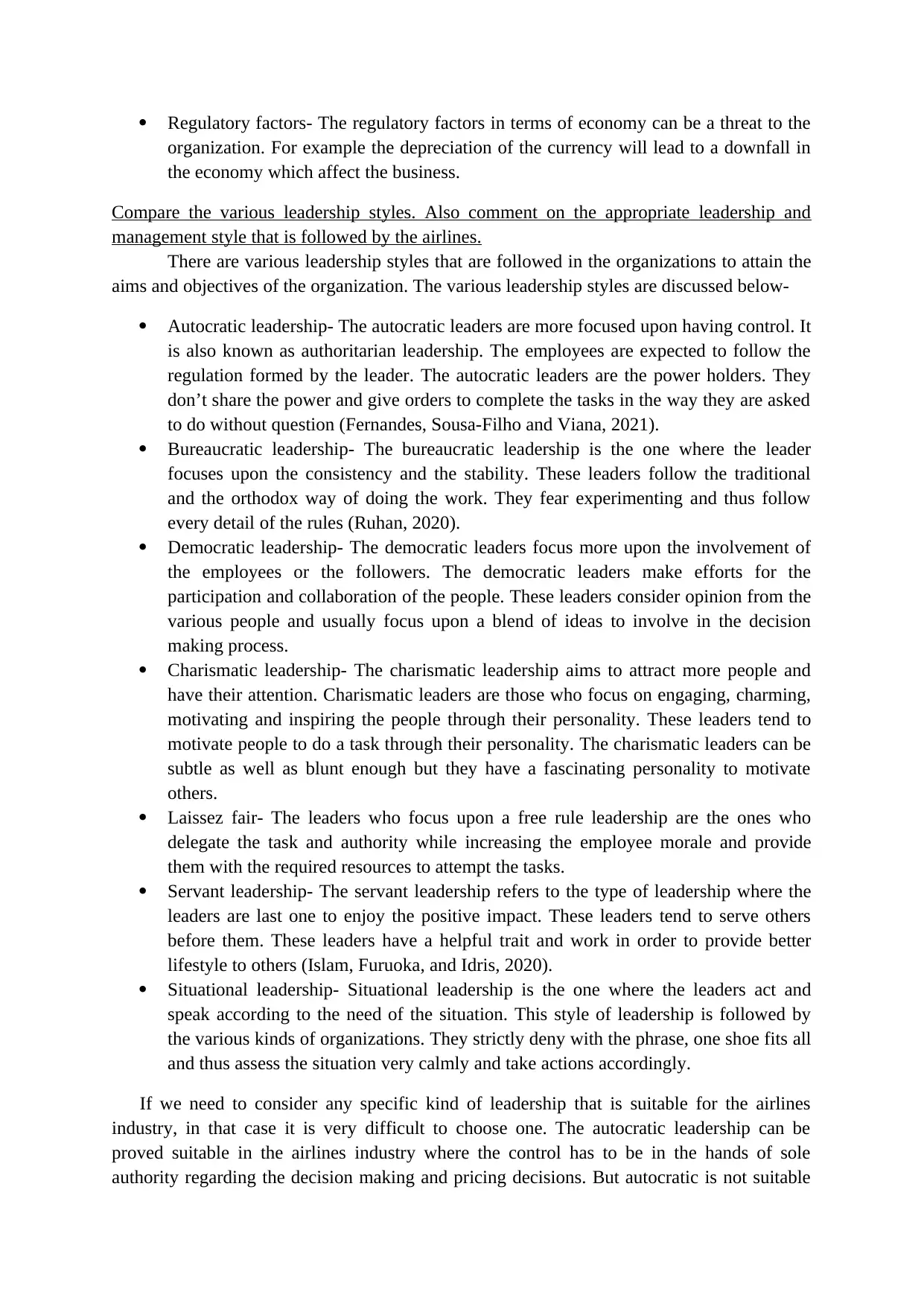
Regulatory factors- The regulatory factors in terms of economy can be a threat to the
organization. For example the depreciation of the currency will lead to a downfall in
the economy which affect the business.
Compare the various leadership styles. Also comment on the appropriate leadership and
management style that is followed by the airlines.
There are various leadership styles that are followed in the organizations to attain the
aims and objectives of the organization. The various leadership styles are discussed below-
Autocratic leadership- The autocratic leaders are more focused upon having control. It
is also known as authoritarian leadership. The employees are expected to follow the
regulation formed by the leader. The autocratic leaders are the power holders. They
don’t share the power and give orders to complete the tasks in the way they are asked
to do without question (Fernandes, Sousa-Filho and Viana, 2021).
Bureaucratic leadership- The bureaucratic leadership is the one where the leader
focuses upon the consistency and the stability. These leaders follow the traditional
and the orthodox way of doing the work. They fear experimenting and thus follow
every detail of the rules (Ruhan, 2020).
Democratic leadership- The democratic leaders focus more upon the involvement of
the employees or the followers. The democratic leaders make efforts for the
participation and collaboration of the people. These leaders consider opinion from the
various people and usually focus upon a blend of ideas to involve in the decision
making process.
Charismatic leadership- The charismatic leadership aims to attract more people and
have their attention. Charismatic leaders are those who focus on engaging, charming,
motivating and inspiring the people through their personality. These leaders tend to
motivate people to do a task through their personality. The charismatic leaders can be
subtle as well as blunt enough but they have a fascinating personality to motivate
others.
Laissez fair- The leaders who focus upon a free rule leadership are the ones who
delegate the task and authority while increasing the employee morale and provide
them with the required resources to attempt the tasks.
Servant leadership- The servant leadership refers to the type of leadership where the
leaders are last one to enjoy the positive impact. These leaders tend to serve others
before them. These leaders have a helpful trait and work in order to provide better
lifestyle to others (Islam, Furuoka, and Idris, 2020).
Situational leadership- Situational leadership is the one where the leaders act and
speak according to the need of the situation. This style of leadership is followed by
the various kinds of organizations. They strictly deny with the phrase, one shoe fits all
and thus assess the situation very calmly and take actions accordingly.
If we need to consider any specific kind of leadership that is suitable for the airlines
industry, in that case it is very difficult to choose one. The autocratic leadership can be
proved suitable in the airlines industry where the control has to be in the hands of sole
authority regarding the decision making and pricing decisions. But autocratic is not suitable
organization. For example the depreciation of the currency will lead to a downfall in
the economy which affect the business.
Compare the various leadership styles. Also comment on the appropriate leadership and
management style that is followed by the airlines.
There are various leadership styles that are followed in the organizations to attain the
aims and objectives of the organization. The various leadership styles are discussed below-
Autocratic leadership- The autocratic leaders are more focused upon having control. It
is also known as authoritarian leadership. The employees are expected to follow the
regulation formed by the leader. The autocratic leaders are the power holders. They
don’t share the power and give orders to complete the tasks in the way they are asked
to do without question (Fernandes, Sousa-Filho and Viana, 2021).
Bureaucratic leadership- The bureaucratic leadership is the one where the leader
focuses upon the consistency and the stability. These leaders follow the traditional
and the orthodox way of doing the work. They fear experimenting and thus follow
every detail of the rules (Ruhan, 2020).
Democratic leadership- The democratic leaders focus more upon the involvement of
the employees or the followers. The democratic leaders make efforts for the
participation and collaboration of the people. These leaders consider opinion from the
various people and usually focus upon a blend of ideas to involve in the decision
making process.
Charismatic leadership- The charismatic leadership aims to attract more people and
have their attention. Charismatic leaders are those who focus on engaging, charming,
motivating and inspiring the people through their personality. These leaders tend to
motivate people to do a task through their personality. The charismatic leaders can be
subtle as well as blunt enough but they have a fascinating personality to motivate
others.
Laissez fair- The leaders who focus upon a free rule leadership are the ones who
delegate the task and authority while increasing the employee morale and provide
them with the required resources to attempt the tasks.
Servant leadership- The servant leadership refers to the type of leadership where the
leaders are last one to enjoy the positive impact. These leaders tend to serve others
before them. These leaders have a helpful trait and work in order to provide better
lifestyle to others (Islam, Furuoka, and Idris, 2020).
Situational leadership- Situational leadership is the one where the leaders act and
speak according to the need of the situation. This style of leadership is followed by
the various kinds of organizations. They strictly deny with the phrase, one shoe fits all
and thus assess the situation very calmly and take actions accordingly.
If we need to consider any specific kind of leadership that is suitable for the airlines
industry, in that case it is very difficult to choose one. The autocratic leadership can be
proved suitable in the airlines industry where the control has to be in the hands of sole
authority regarding the decision making and pricing decisions. But autocratic is not suitable
⊘ This is a preview!⊘
Do you want full access?
Subscribe today to unlock all pages.

Trusted by 1+ million students worldwide
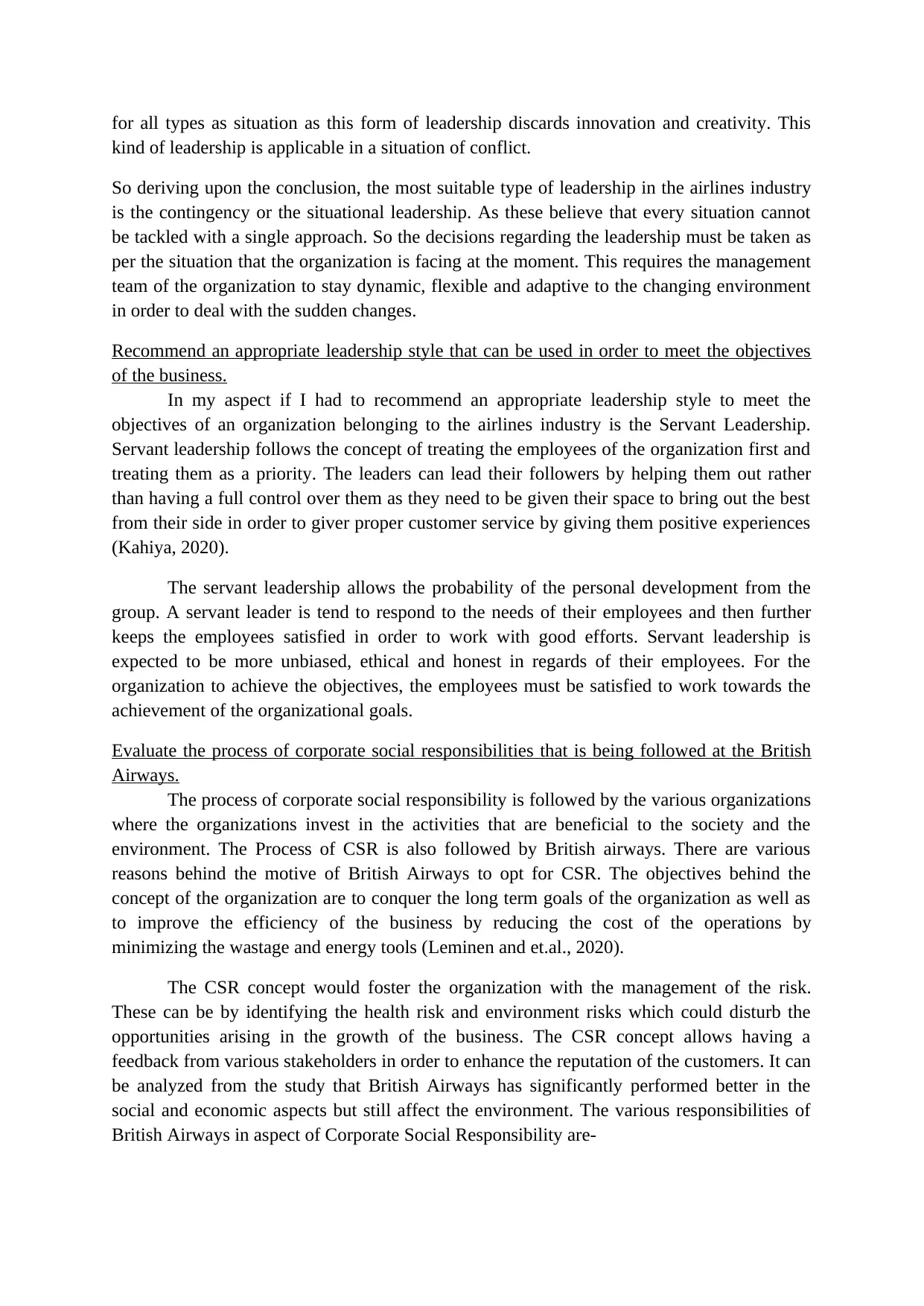
for all types as situation as this form of leadership discards innovation and creativity. This
kind of leadership is applicable in a situation of conflict.
So deriving upon the conclusion, the most suitable type of leadership in the airlines industry
is the contingency or the situational leadership. As these believe that every situation cannot
be tackled with a single approach. So the decisions regarding the leadership must be taken as
per the situation that the organization is facing at the moment. This requires the management
team of the organization to stay dynamic, flexible and adaptive to the changing environment
in order to deal with the sudden changes.
Recommend an appropriate leadership style that can be used in order to meet the objectives
of the business.
In my aspect if I had to recommend an appropriate leadership style to meet the
objectives of an organization belonging to the airlines industry is the Servant Leadership.
Servant leadership follows the concept of treating the employees of the organization first and
treating them as a priority. The leaders can lead their followers by helping them out rather
than having a full control over them as they need to be given their space to bring out the best
from their side in order to giver proper customer service by giving them positive experiences
(Kahiya, 2020).
The servant leadership allows the probability of the personal development from the
group. A servant leader is tend to respond to the needs of their employees and then further
keeps the employees satisfied in order to work with good efforts. Servant leadership is
expected to be more unbiased, ethical and honest in regards of their employees. For the
organization to achieve the objectives, the employees must be satisfied to work towards the
achievement of the organizational goals.
Evaluate the process of corporate social responsibilities that is being followed at the British
Airways.
The process of corporate social responsibility is followed by the various organizations
where the organizations invest in the activities that are beneficial to the society and the
environment. The Process of CSR is also followed by British airways. There are various
reasons behind the motive of British Airways to opt for CSR. The objectives behind the
concept of the organization are to conquer the long term goals of the organization as well as
to improve the efficiency of the business by reducing the cost of the operations by
minimizing the wastage and energy tools (Leminen and et.al., 2020).
The CSR concept would foster the organization with the management of the risk.
These can be by identifying the health risk and environment risks which could disturb the
opportunities arising in the growth of the business. The CSR concept allows having a
feedback from various stakeholders in order to enhance the reputation of the customers. It can
be analyzed from the study that British Airways has significantly performed better in the
social and economic aspects but still affect the environment. The various responsibilities of
British Airways in aspect of Corporate Social Responsibility are-
kind of leadership is applicable in a situation of conflict.
So deriving upon the conclusion, the most suitable type of leadership in the airlines industry
is the contingency or the situational leadership. As these believe that every situation cannot
be tackled with a single approach. So the decisions regarding the leadership must be taken as
per the situation that the organization is facing at the moment. This requires the management
team of the organization to stay dynamic, flexible and adaptive to the changing environment
in order to deal with the sudden changes.
Recommend an appropriate leadership style that can be used in order to meet the objectives
of the business.
In my aspect if I had to recommend an appropriate leadership style to meet the
objectives of an organization belonging to the airlines industry is the Servant Leadership.
Servant leadership follows the concept of treating the employees of the organization first and
treating them as a priority. The leaders can lead their followers by helping them out rather
than having a full control over them as they need to be given their space to bring out the best
from their side in order to giver proper customer service by giving them positive experiences
(Kahiya, 2020).
The servant leadership allows the probability of the personal development from the
group. A servant leader is tend to respond to the needs of their employees and then further
keeps the employees satisfied in order to work with good efforts. Servant leadership is
expected to be more unbiased, ethical and honest in regards of their employees. For the
organization to achieve the objectives, the employees must be satisfied to work towards the
achievement of the organizational goals.
Evaluate the process of corporate social responsibilities that is being followed at the British
Airways.
The process of corporate social responsibility is followed by the various organizations
where the organizations invest in the activities that are beneficial to the society and the
environment. The Process of CSR is also followed by British airways. There are various
reasons behind the motive of British Airways to opt for CSR. The objectives behind the
concept of the organization are to conquer the long term goals of the organization as well as
to improve the efficiency of the business by reducing the cost of the operations by
minimizing the wastage and energy tools (Leminen and et.al., 2020).
The CSR concept would foster the organization with the management of the risk.
These can be by identifying the health risk and environment risks which could disturb the
opportunities arising in the growth of the business. The CSR concept allows having a
feedback from various stakeholders in order to enhance the reputation of the customers. It can
be analyzed from the study that British Airways has significantly performed better in the
social and economic aspects but still affect the environment. The various responsibilities of
British Airways in aspect of Corporate Social Responsibility are-
Paraphrase This Document
Need a fresh take? Get an instant paraphrase of this document with our AI Paraphraser
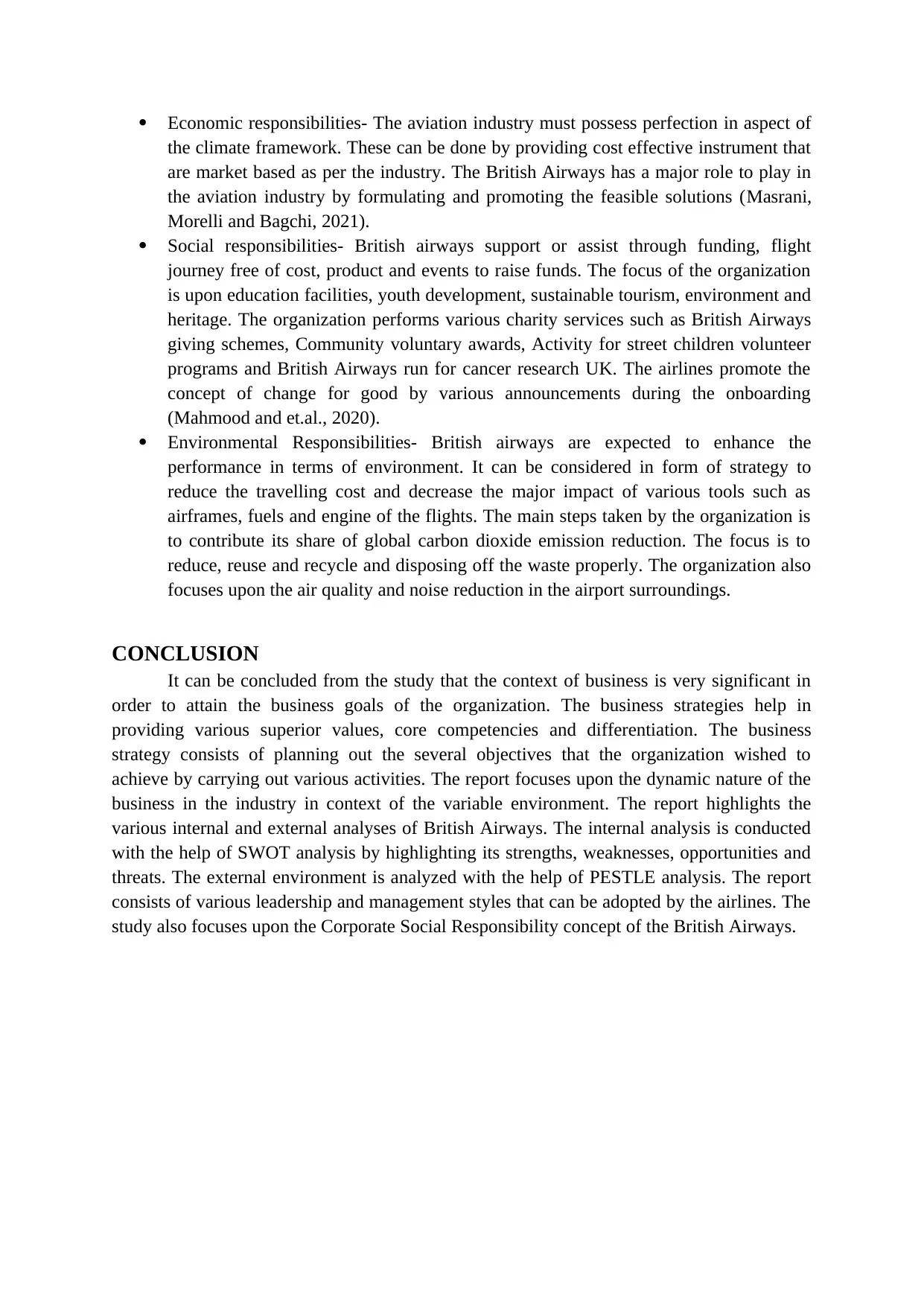
Economic responsibilities- The aviation industry must possess perfection in aspect of
the climate framework. These can be done by providing cost effective instrument that
are market based as per the industry. The British Airways has a major role to play in
the aviation industry by formulating and promoting the feasible solutions (Masrani,
Morelli and Bagchi, 2021).
Social responsibilities- British airways support or assist through funding, flight
journey free of cost, product and events to raise funds. The focus of the organization
is upon education facilities, youth development, sustainable tourism, environment and
heritage. The organization performs various charity services such as British Airways
giving schemes, Community voluntary awards, Activity for street children volunteer
programs and British Airways run for cancer research UK. The airlines promote the
concept of change for good by various announcements during the onboarding
(Mahmood and et.al., 2020).
Environmental Responsibilities- British airways are expected to enhance the
performance in terms of environment. It can be considered in form of strategy to
reduce the travelling cost and decrease the major impact of various tools such as
airframes, fuels and engine of the flights. The main steps taken by the organization is
to contribute its share of global carbon dioxide emission reduction. The focus is to
reduce, reuse and recycle and disposing off the waste properly. The organization also
focuses upon the air quality and noise reduction in the airport surroundings.
CONCLUSION
It can be concluded from the study that the context of business is very significant in
order to attain the business goals of the organization. The business strategies help in
providing various superior values, core competencies and differentiation. The business
strategy consists of planning out the several objectives that the organization wished to
achieve by carrying out various activities. The report focuses upon the dynamic nature of the
business in the industry in context of the variable environment. The report highlights the
various internal and external analyses of British Airways. The internal analysis is conducted
with the help of SWOT analysis by highlighting its strengths, weaknesses, opportunities and
threats. The external environment is analyzed with the help of PESTLE analysis. The report
consists of various leadership and management styles that can be adopted by the airlines. The
study also focuses upon the Corporate Social Responsibility concept of the British Airways.
the climate framework. These can be done by providing cost effective instrument that
are market based as per the industry. The British Airways has a major role to play in
the aviation industry by formulating and promoting the feasible solutions (Masrani,
Morelli and Bagchi, 2021).
Social responsibilities- British airways support or assist through funding, flight
journey free of cost, product and events to raise funds. The focus of the organization
is upon education facilities, youth development, sustainable tourism, environment and
heritage. The organization performs various charity services such as British Airways
giving schemes, Community voluntary awards, Activity for street children volunteer
programs and British Airways run for cancer research UK. The airlines promote the
concept of change for good by various announcements during the onboarding
(Mahmood and et.al., 2020).
Environmental Responsibilities- British airways are expected to enhance the
performance in terms of environment. It can be considered in form of strategy to
reduce the travelling cost and decrease the major impact of various tools such as
airframes, fuels and engine of the flights. The main steps taken by the organization is
to contribute its share of global carbon dioxide emission reduction. The focus is to
reduce, reuse and recycle and disposing off the waste properly. The organization also
focuses upon the air quality and noise reduction in the airport surroundings.
CONCLUSION
It can be concluded from the study that the context of business is very significant in
order to attain the business goals of the organization. The business strategies help in
providing various superior values, core competencies and differentiation. The business
strategy consists of planning out the several objectives that the organization wished to
achieve by carrying out various activities. The report focuses upon the dynamic nature of the
business in the industry in context of the variable environment. The report highlights the
various internal and external analyses of British Airways. The internal analysis is conducted
with the help of SWOT analysis by highlighting its strengths, weaknesses, opportunities and
threats. The external environment is analyzed with the help of PESTLE analysis. The report
consists of various leadership and management styles that can be adopted by the airlines. The
study also focuses upon the Corporate Social Responsibility concept of the British Airways.
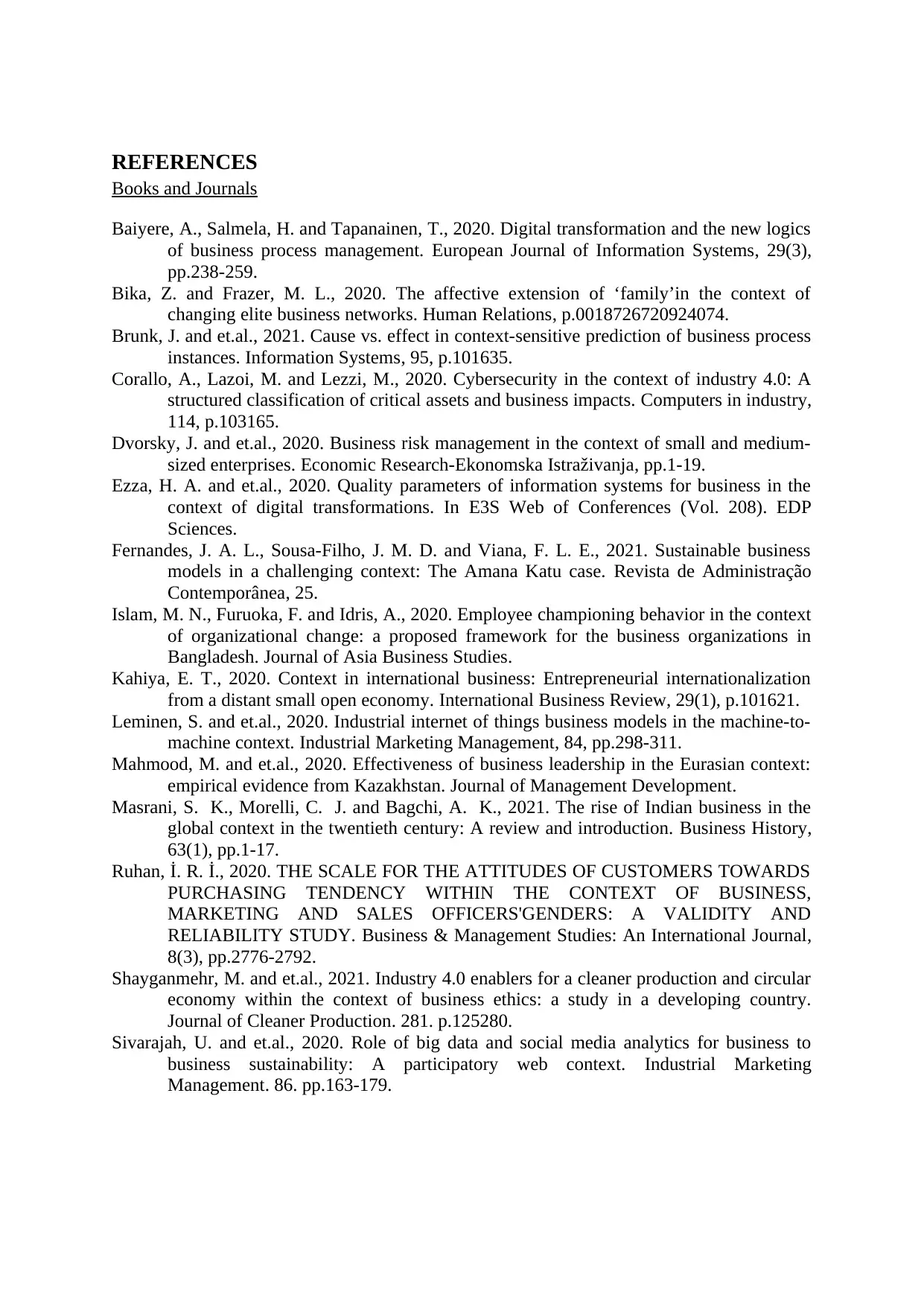
REFERENCES
Books and Journals
Baiyere, A., Salmela, H. and Tapanainen, T., 2020. Digital transformation and the new logics
of business process management. European Journal of Information Systems, 29(3),
pp.238-259.
Bika, Z. and Frazer, M. L., 2020. The affective extension of ‘family’in the context of
changing elite business networks. Human Relations, p.0018726720924074.
Brunk, J. and et.al., 2021. Cause vs. effect in context-sensitive prediction of business process
instances. Information Systems, 95, p.101635.
Corallo, A., Lazoi, M. and Lezzi, M., 2020. Cybersecurity in the context of industry 4.0: A
structured classification of critical assets and business impacts. Computers in industry,
114, p.103165.
Dvorsky, J. and et.al., 2020. Business risk management in the context of small and medium-
sized enterprises. Economic Research-Ekonomska Istraživanja, pp.1-19.
Ezza, H. A. and et.al., 2020. Quality parameters of information systems for business in the
context of digital transformations. In E3S Web of Conferences (Vol. 208). EDP
Sciences.
Fernandes, J. A. L., Sousa-Filho, J. M. D. and Viana, F. L. E., 2021. Sustainable business
models in a challenging context: The Amana Katu case. Revista de Administração
Contemporânea, 25.
Islam, M. N., Furuoka, F. and Idris, A., 2020. Employee championing behavior in the context
of organizational change: a proposed framework for the business organizations in
Bangladesh. Journal of Asia Business Studies.
Kahiya, E. T., 2020. Context in international business: Entrepreneurial internationalization
from a distant small open economy. International Business Review, 29(1), p.101621.
Leminen, S. and et.al., 2020. Industrial internet of things business models in the machine-to-
machine context. Industrial Marketing Management, 84, pp.298-311.
Mahmood, M. and et.al., 2020. Effectiveness of business leadership in the Eurasian context:
empirical evidence from Kazakhstan. Journal of Management Development.
Masrani, S. K., Morelli, C. J. and Bagchi, A. K., 2021. The rise of Indian business in the
global context in the twentieth century: A review and introduction. Business History,
63(1), pp.1-17.
Ruhan, İ. R. İ., 2020. THE SCALE FOR THE ATTITUDES OF CUSTOMERS TOWARDS
PURCHASING TENDENCY WITHIN THE CONTEXT OF BUSINESS,
MARKETING AND SALES OFFICERS'GENDERS: A VALIDITY AND
RELIABILITY STUDY. Business & Management Studies: An International Journal,
8(3), pp.2776-2792.
Shayganmehr, M. and et.al., 2021. Industry 4.0 enablers for a cleaner production and circular
economy within the context of business ethics: a study in a developing country.
Journal of Cleaner Production. 281. p.125280.
Sivarajah, U. and et.al., 2020. Role of big data and social media analytics for business to
business sustainability: A participatory web context. Industrial Marketing
Management. 86. pp.163-179.
Books and Journals
Baiyere, A., Salmela, H. and Tapanainen, T., 2020. Digital transformation and the new logics
of business process management. European Journal of Information Systems, 29(3),
pp.238-259.
Bika, Z. and Frazer, M. L., 2020. The affective extension of ‘family’in the context of
changing elite business networks. Human Relations, p.0018726720924074.
Brunk, J. and et.al., 2021. Cause vs. effect in context-sensitive prediction of business process
instances. Information Systems, 95, p.101635.
Corallo, A., Lazoi, M. and Lezzi, M., 2020. Cybersecurity in the context of industry 4.0: A
structured classification of critical assets and business impacts. Computers in industry,
114, p.103165.
Dvorsky, J. and et.al., 2020. Business risk management in the context of small and medium-
sized enterprises. Economic Research-Ekonomska Istraživanja, pp.1-19.
Ezza, H. A. and et.al., 2020. Quality parameters of information systems for business in the
context of digital transformations. In E3S Web of Conferences (Vol. 208). EDP
Sciences.
Fernandes, J. A. L., Sousa-Filho, J. M. D. and Viana, F. L. E., 2021. Sustainable business
models in a challenging context: The Amana Katu case. Revista de Administração
Contemporânea, 25.
Islam, M. N., Furuoka, F. and Idris, A., 2020. Employee championing behavior in the context
of organizational change: a proposed framework for the business organizations in
Bangladesh. Journal of Asia Business Studies.
Kahiya, E. T., 2020. Context in international business: Entrepreneurial internationalization
from a distant small open economy. International Business Review, 29(1), p.101621.
Leminen, S. and et.al., 2020. Industrial internet of things business models in the machine-to-
machine context. Industrial Marketing Management, 84, pp.298-311.
Mahmood, M. and et.al., 2020. Effectiveness of business leadership in the Eurasian context:
empirical evidence from Kazakhstan. Journal of Management Development.
Masrani, S. K., Morelli, C. J. and Bagchi, A. K., 2021. The rise of Indian business in the
global context in the twentieth century: A review and introduction. Business History,
63(1), pp.1-17.
Ruhan, İ. R. İ., 2020. THE SCALE FOR THE ATTITUDES OF CUSTOMERS TOWARDS
PURCHASING TENDENCY WITHIN THE CONTEXT OF BUSINESS,
MARKETING AND SALES OFFICERS'GENDERS: A VALIDITY AND
RELIABILITY STUDY. Business & Management Studies: An International Journal,
8(3), pp.2776-2792.
Shayganmehr, M. and et.al., 2021. Industry 4.0 enablers for a cleaner production and circular
economy within the context of business ethics: a study in a developing country.
Journal of Cleaner Production. 281. p.125280.
Sivarajah, U. and et.al., 2020. Role of big data and social media analytics for business to
business sustainability: A participatory web context. Industrial Marketing
Management. 86. pp.163-179.
⊘ This is a preview!⊘
Do you want full access?
Subscribe today to unlock all pages.

Trusted by 1+ million students worldwide
1 out of 9
Related Documents
Your All-in-One AI-Powered Toolkit for Academic Success.
+13062052269
info@desklib.com
Available 24*7 on WhatsApp / Email
![[object Object]](/_next/static/media/star-bottom.7253800d.svg)
Unlock your academic potential
Copyright © 2020–2025 A2Z Services. All Rights Reserved. Developed and managed by ZUCOL.





